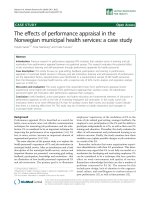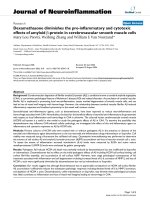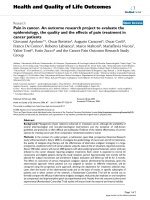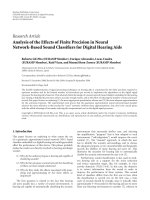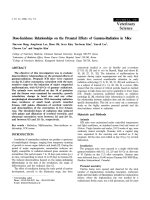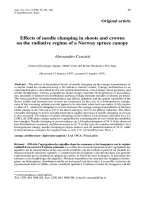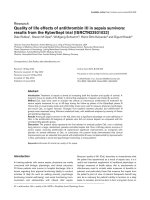Effects of polymethylmethacrylate on the stability of screw fixation in mandibular angle fractures: A study on sheep mandibles
Bạn đang xem bản rút gọn của tài liệu. Xem và tải ngay bản đầy đủ của tài liệu tại đây (966.82 KB, 6 trang )
Int. J. Med. Sci. 2018, Vol. 15
Ivyspring
International Publisher
1466
International Journal of Medical Sciences
2018; 15(13): 1466-1471. doi: 10.7150/ijms.26697
Research Paper
Effects of polymethylmethacrylate on the stability of
screw fixation in mandibular angle fractures: A study on
sheep mandibles
Abdulkadir Burak Cankaya, Metin Berk Kasapoglu, Mehmet Ali Erdem, Cetin Kasapoglu
Istanbul University, Faculty of Dentistry, Department of Oral and Maxillofacial Surgery, Istanbul Turkey
Corresponding author: Abdulkadir Burak Cankaya, Asoc. Prof., Istanbul University, Faculty of Dentistry, Department of Oral and Maxillofacial Surgery,
34093, Istanbul, Turkey. e-mail:
© Ivyspring International Publisher. This is an open access article distributed under the terms of the Creative Commons Attribution (CC BY-NC) license
( See for full terms and conditions.
Received: 2018.04.16; Accepted: 2018.08.08; Published: 2018.09.11
Abstract
Aim: Malfixed miniplates can impair fracture healing, and the screw pilot holes may widen during
repeated fixation trials. This in vitro study explored the extent to which screw fixation of mandibular
angle fractures could be improved by augmenting the drilling holes with polymethylmethacrylate
(PMMA).
Materials and Methods: We measured stabilization by recording specimen displacement under a
vertical force of 50 N applied using a hydraulic tester. We included 20 hemimandibles from sheep
(average weight 40 kg). The specimens were randomly divided into two groups of 10 and pilot holes
were created in the angulus region using a drill 1.2 mm in diameter. Next, we performed
osteotomies simulating angulus fracture repair. In group 1, the fracture site was fixed using
non-compression miniplates and four screws were inserted to the maximal possible extent
employing a mechanical screwdriver. In group 2, the pilot drill holes were filled with PMMA prior to
miniplate fixation. Then vertical forces of 50 N were applied to the molar region and the
displacements were measured. The Shapiro–Wilks test was used to compare the two groups.
Result: The maximum average displacement in the experimental group was significantly lower than
that in the control group (p=0.026). Thus, PMMA-augmented screws better stabilized bone,
affording reliable fixation.
Key words: polymethylmethacrylate, fixation screws, bone, displacement
Introduction
Of the various mandibular fractures, angular
ones are the most frequently encountered (30% of all
fractures).
The
optimal
treatment
remains
controversial. The anatomical neighborhood and
biomechanical
difficulties
associated
with
manipulation of the bone suggest that several
treatment options should be explored [1, 2]. Many
studies have used different numbers of miniplates
and screws at different positions in the angular
region. In one study, a single miniplate fixed to the
lateral aspect of the mandibular angle served as a
tension band, and was associated with a low
complication rate (12–16%) [3, 4]. Champy et al.
reported that miniplate placement on the lateral
aspect of the mandible enhanced fracture healing [5].
It is crucially important to apply miniplates
correctly. However, the angular region is not easily
accessible; the buccal tissues restrict surgical access.
Malcontoured/malfixed miniplates may impair
fracture healing, which is associated with bone
resorption and screw loosening [6, 7]. It is essential to
fix miniplates and screws to the bone firmly. Drilling
and forces applied by screws to thin cortical bone can
cause new fractures. In addition, vessels, nerves, and
tooth roots can be damaged during these steps [8, 9].
Often, repeated fitting trials are required to ensure the
Int. J. Med. Sci. 2018, Vol. 15
desired stability, causing complications such as screw
loosening, displacement, and back-out [10].
Polymethylmethacrylate (PMMA) is widely used
in orthopedic surgery. It is a biocompatible acrylic
resin that can be prepared during or prior to operation
[11]. During orthopedic surgery, PMMA is used to
ensure bonding to bone. Many studies have shown
that pedicle screw augmentation with cements such as
PMMA improve screw fixation [12]. Here, we
explored the effects of PMMA on screw stability. We
applied PMMA (Cemex, Tecres, Italy) to screws
before attaching them to bone. Our hypothesis was
that mandible angle fractures treated in this way
would exhibit less displacement under hydraulic
pressure.
1467
prior to use; PMMA assumes a toothpaste-like
consistency over 3 min as suggested by the
manufacturer company. Using a 10 mL syringe,
PMMA was applied to the screw tracts via retrograde
injection prior to miniplate fixation (Fig. 4).
Materials and Methods
The whole study was done on the same day. We
obtained 20 hemimandibles from sheep (average
weight 40 kg) that had been fed under similar
conditions. The specimens were kept moist and
refrigerated at 4 °C until testing procedures were
performed.
Skin, muscle tissues, coronoid processes and
condyles were removed from the mandibles to create
the physical conditions required for the experiment.
For each specimen, the boundaries of an angular
fracture line were first drawn with a surgical pen. The
hemimandibles were randomly divided into two
groups of 10.
To create the pilot holes, grade 2, titanium,
non-compression, four-holed straight miniplates 1
mm thick (Medplates, Istanbul, Turkey) were placed
on the angulus, centered on the osteotomy line (Fig.
1). The drill was 1.2 mm in diameter (Medplates) and
was operated at 1,500 rpm while holding the
miniplate to ensure correct localization of the holes.
Physiological saline was used to cool the bone and
wash away debris formed during drilling.
Under saline irrigation, a diamond particle saw
driven by an electric induction motor was used to
create bicortical osteotomies in the cortical bone. As
the sheep mandible is smaller and weaker than the
human mandible, a chisel and a hammer were then
used to create a proper angle fracture (Figs. 2, 3).
For an accurate stabilization and standardized
screw force appliance, test materials were clamped
between two steel plates. All the screws were inserted
by the same surgeon. For avoiding over drilling, no
pressure was applied on the screws. In group 1
(control), fracture line stabilization featured
placement of non-compression miniplates fixed with
titanium grade 5 screws 2.0 mm in diameter and 11
mm long (Medplates). In group 2 (experimental),
PMMA (Cemex, Tecres, Italy) was prepared 3 min
Fig. 1. Osteotomy line was drawn using a surgical pen and preparation of the pilot
holes.
Fig. 2. A diamond particle saw.
Fig. 3. A chisel used as an osteotome.
As mechanical screwdriver, a torque adjustable
physiodispenser was used in both groups. In dental
implant insertion mode, screws were placed at 40 Nm
of torque (Fig. 5).
Immediately after injection, the screws were
inserted until they stopped turning (Fig. 6).
Int. J. Med. Sci. 2018, Vol. 15
1468
mm/min (ELISTA Electronic Informatic System
Design Ltd., Istanbul, Turkey). After the device had
been calibrated at 0 N, increasing forces from 0–50 N
were applied to the occlusal plane.
Fig. 4. PMMA application using a 10 mL syringe.
Fig. 7. Hydraulic test device
Fig. 5. Torque adjustable physiodispenser
Fig. 8. L-shaped fixation device
Fig. 6. Insertion of screws using an electronic screwdriver.
An L-shaped metal device with three lateral
screws on each side was used to fix the
hemimandibles to the hydraulic test device (Universal
Autograph AGS®, Shimadzu Scientific Instruments,
Kyoto, Japan) (Figs. 7,8). The occlusal surfaces of the
teeth lay parallel to the horizontal plane of the
machine, and were flattened with resin so that the
force cell could not slip (Fig. 9). A progressive vertical
force was applied in the area of the molar teeth; the
force sensor was fixed at the head of the test machine.
The machine was programmed to stop force
application at 50 N and then to record the maximum
vertical displacement at a displacement speed of 5
Fig. 9. Addition of resin to flatten the occlusal surfaces.
We compared data from the two groups using
IBM SPSS software ver. 22 (SPSS IBM, Istanbul,
Turkey). The Shapiro–Wilks test was used to confirm
that the data were normally distributed. Student’s
Int. J. Med. Sci. 2018, Vol. 15
1469
t-test was used to compare the two groups and the
level of significance was set to p<0.05.
Results
None of the study models failed during testing
and they met the criteria for this biomechanical study.
The
displacements
and
mean
maximum
displacements (with SDs) of each group under a force
of 50 N are shown in Tables 1 and Figure 10. The
average maximum displacement of the experimental
group was significantly lower than that of the control
group (p=0.026, p <0.05). Only one experimental
specimen exhibited a displacement greater than the
mean control value.
Table 1. Displacements of at 50 N of applied force.
Control
Group
C1
C2
C3
C4
C5
C6
C7
C8
C9
C10
Mean
(SD)
Maximum Displacement
in Millimeters
6.64120
4.22663
3.25470
8.36833
10.9430
3.20330
4.76953
8.49467
4.53457
7.11283
6.15±2.58
Experimental
Group
E1
E2
E3
E4
E5
E6
E7
E8
E9
E10
Mean (SD)
Maximum Displacement
in Millimeters
3.35977
6.33183
2.73140
3.82783
4.72607
2.26630
3.09780
4.74117
4.40117
3.36447
3.88±1.19
Figure 10. Mean displacements of sheep hemimandibles.
Discussion
In this study, we aimed to investigate whether
the PMMA cement improved the fixation of the
screws to the bones during miniplate osteosynthesis
and the stability of fracture fragments. For this reason,
it was aimed to compare the values of two groups
under a certain force rather than the value of force
applied. There are many studies in the literature
investigating miniplate / screw durability and
stability under certain forces. In these studies,
properties such as the length, thickness, material,
number of screws, screw length, screw diameter were
examined and various results were obtained. In our
study, we aimed to investigate whether we could
increase the stability of the fracture line with PMMA
cement without changing the screw-plate systems
used as standard.
Of all mandibular fractures, angle fractures are
the most common, and the optimal treatment options
are not clear [1, 2]. Champy miniplate fixation has
been shown to be effective in many clinical trials and
studies. Fixation of a single miniplate with
monocortical screws is reliable, associated with few
complications when treating mandibular angle
fractures [13, 14]. Sheep mandibles resemble human
mandibles in terms of both thickness and size and
thus are commonly used experimentally [15].
Researchers
use
resin
models
to
ensure
standardization in tests. However, besides their
advantages in standardization, the resin models show
different properties from fresh bone due to their
elasticity properties. Use of fresh mandibles of
animals is the best indication for in-vitro studies [24].
We employed fresh sheep mandibles to mimic the
human mandible.
In a study of mandibular angle fractured patients
treated with Champy technique with miniplate
osteosynthesis, the bite forces between molar teeth
was 90 N in the first week and up to 148 N in the sixth
[25]. To collect clinically relevant data, we applied a
vertical force of 50 N when evaluating screw
displacement and resistance immediately after
inserting the screws. Since we want to evaluate the
stabilization obtained during the operation, a vertical
force of 50 N was preferred which was less than the
value of the first week bite forces. Findings of forces
lower than 50 N were not included in the study as the
reliability of the force sensor was suspected under
forces smaller than 50 N. Heidemann et al. showed
that the holding power of a pilot screw hole decreased
when the inner diameter was >80% larger than the
screw diameter. Here, the holes were of diameter 1.2
mm, thus 66% of the screw external diameter (2.0 mm)
[16].
Many methods are used to improve screw
retention forces. It is not always possible to increase
screw diameter or length because of the anatomical
neigborhood. In addition, use of large-diameter
screws creates a risk of cortical plate fracture. Most
iatrogenic trauma occurs during drilling of pilot holes
or fastening of screws [17–19]. Fixation must be
enhanced without increasing screw diameter or
length.
We believe that the application of PMMA to the
prepared screw holes reinforces the connection of the
screw to the bone by filling the gaps between the
Int. J. Med. Sci. 2018, Vol. 15
screw and the bone to form extra retention areas. The
results of this study supports our hypothesis as the
displacement in the PMMA augmented experiment
group is significantly lower than in the control group.
Many studies have shown that calcium sulfate,
calcium phosphate, and PMMA cements are effective
in terms of screw augmentation [12–14, 20]. PMMA is
the most readily available, cheapest, and
biocompatible of these materials, allowing immediate
fixation to cancelleous bone (which is not usually the
case for the other materials; [20]). Screws augmented
with PMMA cement exhibit inproved primary
stability [21, 22]. However, there are no data on using
this technique in the maxillofacial region. We used
PMMA cement to augment screws, seeking to reduce
hemimandible displacement under a vertical force.
Our results support the studies cited above.
PMMA leakage into, and PMMA-mediated
compression of, soft tissues, nerves, and vessels is of
concern. In addition, it is unclear what the
appropriate quantity of PMMA to inject is. We believe
that greater amounts of PMMA improve fixation
stregths. However, as the amount of PMMA increases,
there may be leakage to the surrounding tissues and
fracture line, which may lead to delayed recovery.
We should mention several key features that
minimize cement leakage. First, a short syringe needle
should be used; it is important to avoid penetrating
the lingual cortex. We had to work quickly before the
PMMA hardened and we perforated the lingual
cortices of a few specimens. Second, PMMA of high
viscosity should be used; this minimizes leakage. We
injected PMMA when it had a toothpaste-like
viscosity. Third, we used the retrograde injection
method of Chang et al. to place the PMMA [10]. This
fills the entire screw tract, improving fixation stregth
[19]. Fourth, after hole-filling, the monocortical screws
and miniplate should be placed immediately.
Three-dimensional (3D) navigation using
computed tomography can be used to place both
screws and PMMA [22]. Yazu et al. employed
fenestrated screws to reduce cement leakage [23];
such screws were superior. These screws are of the the
same shape as ordinary screws, but are hollow and
bear 20 small holes 1.3 mm in diameter. Cement
fixation of such screws in osteoporotic spines was
better than cement fixation of ordinary screws. We
suggest that PMMA injection through fenestrated
screws, or under the guidance of a 3D navigation
system, would afford safer and better integration with
bone.
The rapid curing of the PMMA cement was one
of the hardest points in the experiment. We have
solved this problem by preparing separate PMMA
cements for each hemi mandible. In situations where
1470
more than one miniplate should be used clinically, we
recommend preparing separate PMMA cements for
each miniplate. Otherwise, hardened PMMA cement
makes screw- pilot hole adaptation difficult or
impossible. As the freshness of the hemi mandibles
were important for obtaining significant results
number of subjects used were limited. Force applied
in only one direction and the living tissue reactions of
the PMMA cement were determined as the limiting
factors of this in vitro study.
Conclusion
In this study, we aimed to increase the stability
of the fracture lines while decreasing the
displacement
values
without
changing
the
screw-plate systems. According to our results, we
have concluded that stabilization of the fracture line is
significantly better in the PMMA augmented
experiment group.
In clinical practice, especially when rigid fixation
is impaired, we believe that fracture line stability can
be guaranteed by PMMA augmented support when
the plate screw is not fully setted and the fixation
rigidity is suspected.
Competing Interests
The authors have declared that no competing
interest exists.
References
1.
2.
3.
4.
5.
6.
7.
8.
9.
10.
11.
12.
13.
Braasch DC, Abubaker AO. Management of mandibular angle fractures. Oral
Maxillofacial Surg Clin N AM 2013; 25:591–600
Chuong R, Donoff RB, Guralnick WC. A retrospective analysis of 327
mandible fractures. J Oral Maxillofac Surg 1983; 41:305–9
Champy M, Lodd JP, Schmitt R, et al. Mandibular osteosynthesis by miniature
screwed plates via a buccal approach. J Maxillofac Surg 1978; 6:14
Barry CP, Kearns GJ. Superior border plating technique in the management of
isolated mandibular angle fractures: A retrospective study of 50 consecutive
patients. J Oral Maxillofac Surg 2007; 65:1544–9
Champy M, Wilk A, Schnebelen JM. Treatment of mandibular fractures by
means of osteosynthesis without intermaxillary immobilization according to
F.X. Zahn. Mund Kiefeheilkd Zentralbl 1975; 63:339–41
Poon CC, Verco S. Evaluation of fracture healing and subimplant bone
response following fixation with a locking miniplate and screw system for
mandibular angle fractures in a sheep model. Int J Oral Maxillofac Surg. 2013
Jun;42(6):736–45
Haug RH, Street CC, Goltz M. Does Plate Adaptation Affect Stability? A
biomechanical comparison of locking and nonlocking plates. J Oral Maxillofac
Surg. 2002 Nov; 60(11):1319–26
Schortingbuis J, Bos RRM, Vissink A: Complications of internal fixation of
maxillofacial fractures with microplates. J Oral Maxillofac Surg 1999;
57:130–134
Aziz SR, Ziccardi VB, Borah G: Current therapy: Complications associated
with rigid internal fixation of facial fractures. Compend Contin Educ Dent
2005; 8:565–571
Chang MC, Liu CL, Chen TH. Polymethylmethacrylate augmentation of
pedicle screw for osteoporetic spinal surgery. Spine (Phila Pa 1976). 2008 May
1; 33(10):E317–24
Lye KW, Tideman H, Wolke JC, Merkx MA, Chin FK, Jansen JA.
Biocompatibility and bone formation with porous modified PMMA in normal
and irradiated mandibular tissue. Clin Oral Implants Res. 2013 Aug;
24,100:100–9
Kayanja M, Evans K, Milks R, et al. The mechanics of polymethylmethacrylate
augmentation. Clin Orthop Relat Res 2006; 443:124–30.
Linhardt O, Luring C, Matussek J, et al. Stability of pedicle screw after
kyphoplasty augmentation: An experimental study to compare transpedicular
screw fixation in soft and cured kyphoplasty cement. J Spinal Disord Tech
2006; 19:87–91
Int. J. Med. Sci. 2018, Vol. 15
1471
14. Girardo M,Cinelle P, Gargiulo G et al. Surgical treatment of osteoporotic
thoraco-lumbar compressive fractures: The use of pedicle screw with
augmentation PMMA. Eur Spine J. 2017 Oct; 26(Suppl 4):546–551
15. Pektas ZO, Bayram B, Balcık C, Develi T, Uckan S. Effects of different
mandibular fracture patterns on the stability of miniplate screw fixation in
angle mandibular fractures. Int J Oral Maxillofac Surg. 2012 Mar; 41(3):339–43
16. Heidemann W, Gerlach KL,Grobel KH, Kollner HG. Influence of different
pilot hole sizes on torque measurements and pullout analysis of
osteosynthesis screws. J Craniomaxillofac Surg. 1998 Feb; 26(1):50–5
17. Schortingbuis J, Bos RRM, Vissink A: Complications of internal fixation of
maxillofacial fractures with microplates. J Oral Maxillofac Surg 1999,
57:130–134
18. Wittenberg RH, Lee K-S, Shea M, White AA, Hayes WC. Effect of screw
diameter, insertion technique, and bone cement augmentation of pedicular
screw fixation strength. Clin Orthop 1993; 296:278–287
19. Hirano T, Hasegawa K, Wasio T et al. Fracture risk during pedicle screw
insertion in osteoporotic spine. J Spinal Disord 1998; 11:493–497
20. Renner SM, Lim TH, Kim WJ et al. Augmentation of pedicle screw fixation
stregth using an injectable calcium phosphate cement as a function of injection
timing and method. Spine (Phila Pa 1976). 2004 Jun 1; 29(11):E212–6
21. Frankel BM, D’Agostino S et al. A biomechanical cadaveric analysis of
polymethylmethacrylate-augmented pedicle screw fixation. J Neurosurg
Spine 2007; 7:47–53
22. Yuan Q, Zhang G, Wu J et al. Clinical evaluation of the
polymethylmethacrylate-augmented thoracic and lumbar pedicle screw
fixation guided by the three-dimensional navigation for the osteoporosis
patients. Eur Spine J (Germany) 2015; 24(5):1043–1050
23. Yazu M, Kin A, Kosaka R et al. Efficacy of novel-concept pedicle screw fixation
augmented with calcium phosphate cement in the osteoporotic spine. J Orthop
Sci 2005; 10:56–61
24. Foley WL, Beckman TW. In vitro comparison of screw versus plate fixation in
the sagittal split osteotomy. Int J Adult Orthodon Orthognath Surg. 1992;
7:147-151
25. Gerlach KL, Schwarz A. Bite forces in patients after treatment of mandibular
angle fractures with miniplate osteosynthesis according to Champy. Int. J.
Oral Maxillofac. Surg. 2002; 31: 345–348.
